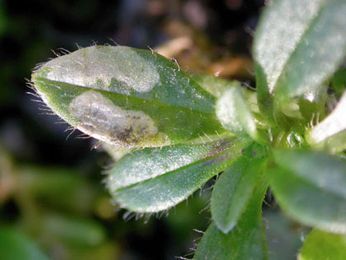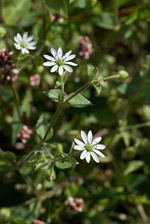|
||||||
|
MYOSOTON. Water Chickweed. [Caryophyllaceae] |
|
|
Water Chickweed (M. aquaticum) is the only species of Myosoton recorded in Britain. It is a native species. The BSBI provide a downloadable plant crib for Stellaria nemorum vs Myosoton aquaticum. Four British miners are recorded on Myosoton. A key to the European miners recorded on Stellaria including Myosoton is provided in Bladmineerders van Europa. |
|
Key for the identification of the known mines of British |
1a > Leaf-miner and case-bearer: Larva mines leaves, forming a case from an excised mine. This case is later extended, and widened by slitting the ventral side to insert a gusset. The full-grown case is 8 mm long with a single ventral keel. Full grown larva in a slender greyish white three-valved tubular silken case of c. 8 mm; mouth angle about 45°. Often several cases together on a small number of plants. |
|
Coleophora solitariella Zeller, 1849 [Lepidoptera: Coleophoridae]. |
1b > Leaf-miner: A white linear-blotch mine, the linear section sometimes not detectable as it becomes enveloped in later blotch (Spencer, 1976: 162-3, figs 296-7). Upper-surface, less often lower-surface, corridor, followed, and often overrun, by a large blotch. Even when the corridor is overun, it usually remains recognisable in the frass pattern. The mine looks whitish in the field. The blotch does not contain much frass, in the form of small black grains, dispersed and stuck to the floor of the mine. Feeding punctures upper-surface (always?). Pupation outside the mine. A common miner, forming a white linear blotch mine (the blotch may obscure the linear portion of the mine) in both native and garden plants. |
|
Amauromyza flavifrons (Meigen, 1830) [Diptera: Agromyzidae]. |
1c > Leaf-miner: Upper side blotch mine beginning with a deeper, almost full depth corridor. Frass grains not in thread-like pieces, irregularly scattered. In the large, later blotch indistinct primary and secondary frass lines are found; the frass accumulated in the middle. Each mine begins with one, rarely two, oval egg shells attached to the leaf underside. Sometimes a number of of young mines, and eggs, on one leaf. The first part of the mine is a tortuous corridor, quickly turning into a large blotch. Most of the blotch is full depth, only some patches are upper-surface, and greenish in transparency. According to the literature copious frass in present in dispersed lumps. In my experience the larva -that then looks very dark- may accumulate all frass in its body. The larva is capable of leaving its mine, and starting a new one elsewhere. These secondary mines can be recognised by the large hole that was made by the larva when entering. Pupation outside the mine. A gallery then a blotch, larger and deeper than Amauromyza flavifrons. In large leaves the mine is upper surface and all in one piece. In small leaves the whole leaf may be covered by a full depth mine with the larva mining several leaves in British leafminers. |
|
Pegomya flavifrons (Walker, 1849) [Diptera: Anthomyiidae]. |
1d > Leaf-miner: The mine starts as a long, narrow, winding corridor running towards the midrib, widening to a blotch. Usually upper-surface, but in small leaves also full-depth parts may occur. The blotch has broad lobes; in their ends most frass is accumulated in the form of green patches or clouds. Sometimes several larvae share mine. Pupation usually in the soil, less often in the leaf (and then generally not in the mine itself but in a small separated mine, that may even be made in the petiole). |
 Mine of Scaptomyza graminum on Cerastium glomeratum Image: © Jean-Yves Baugnée (Bladmineerders van Europa) |
|
Scaptomyza graminum (Fallén, 1823) [Diptera: Drosophilidae]. |
| Last updated 06-Jul-2019 Brian Pitkin | ||

